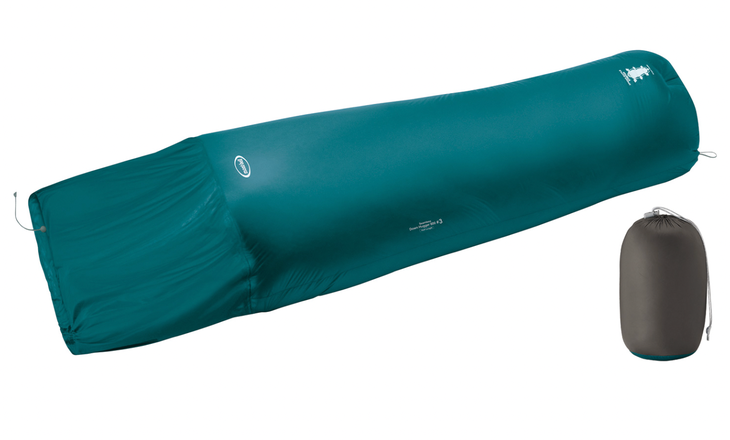Products You May Like
Going ultralight is easy when conditions are perfect. But as the seasons change, things get tougher. Chief among the challenges of shoulder season hiking is staying warm while keeping your pack weight down. It’s a simple fact that cold weather will force you to carry more and heavier gear in order to stay comfortable and safe. Still, there are ways to get the best of both worlds. Here are our best tips on how to tweak your ultralight kit when the shoulder seasons hit.
Adjust Your Baselayers
Going ultralight in colder weather is all about optimizing your gear. An ultra-breathable summer baselayer still wicks moisture when the temperatures drop, but it provides next to no insulation or warmth. To make the most of your layering system, opt for a baselayer that’s both wicking and warming. One unconventional choice? A fleece.
Fleeces are largely used as insulation, but they work just as well—if not better—as a baselayer. In terms of warmth-to-weight ratio, fleece pales in comparison to down insulation. But modern “technical” fleeces have all the moisture-wicking capabilities of a good baselayer, so you could argue that using fleece as anything other than a next-to-skin layer wastes its potential.
For a good baselayer fleece, look for one that’s thin (to boost breathability) and not too feature-laden (so it will be comfortable without another layer under it). At just 4.5 ounces, the KUIU Peloton 97 is a good option, as are any number of products made from Polartec Alpha Direct—an ultralight, nearly see-through fleece fabric that many lightweight backpackers have adopted due to its superior breathability.
Go With Down
Since down has the best warmth-to-weight ratio of any insulation, adding more of it to your kit to replace other layers is an obvious choice. However, it’s also an expensive one, which leads many ultralighters to supplement their down bags and puffies with heavier, cheaper gear. While this might be the right decision for your wallet, it doesn’t make much sense from an ultralight perspective. Any number of cold weather options, from sleeping bag liners to merino wool midlayers, will simply weigh more while offering less warmth than simply opting for a bag or jacket with more ounces of down fill.
If the cost of a warmer down jacket or bag is prohibitive, other down products are still your best and lightest alternatives. Supplement your puffy with a down vest rather than a thick fleece, and your sleeping bag with a down blanket rather than a liner. Whatever you choose, make sure that the down has room to loft.
Experiment with a Half Bag
If your kit already contains a high-loft puffy jacket, one unconventional ultralight sleeping system is to pair it with a half-length sleeping bag rather than using a full bag. Originally developed as an alpine bivy technique by French mountaineers, the half bag (known to its French creators as a pied d’elephant, or elephant’s foot) is a way to utilize an ultra-warm down jacket to its full effect. Rather than balling it up to use as a pillow or taking it off halfway through the night because you’re overheating, the half bag method allows your puffy to serve a vital role in your sleep system. Plus, this method gives you extra incentive to bring along your warmest jacket rather than making do with a less insulating, ultralight option—a choice you’ll appreciate once you’re up and cooking breakfast.
A few concessions: This probably isn’t a great strategy for cold sleepers, since a half bag and jacket combo is draftier than a full length sleeping bag with the same amount of down fill. And if you’re a fidgety sleeper, the added nuisance of keeping your hands by your sides under the half bag might be a deal breaker.

Supplement Your Sleeping Pad
One of the simplest ways to sleep warmer in cold weather is to upgrade your sleeping pad to one with more insulating power and a higher R-value. But while a plush sleeping pad might be a good purchase for winter campers, it might be a needless expense for people just looking to extend their summer kits into the shoulder seasons. As an alternative, consider supplementing your sleeping pad with items you’re already carrying. A common choice is to put your empty backpack under your feet, especially if you’re using a torso- or knee-length pad. If you’re not already sleeping in all of your clothes, fold them up and use them under your pad as extra insulation, as well (provided that they aren’t still damp from hiking). If that doesn’t seem like enough, it might be time to buy a new pad—but consider a supplemental one rather than a replacement. An ultra-thin foam pad is inexpensive, weighs about 3 ounces, and when layered under the sleeping pad you already have, can boost its warmth just enough for shoulder season comfort.
Get your Calories In
If there’s one thing that can keep you warmer than down insulation, it’s your own metabolism. Staying warm while you’re on the move and burning calories is fairly simple, but it’s more difficult at night in your sleeping bag. Luckily, the simple act of digesting and processing food can have a warming effect. Forget about your normal daily eating habits and eat something fatty or sugary right before you turn in for the night. Since fats metabolize more slowly in the body, some people swear by taking a shot of olive oil before bed. (Bonus ultralight cred: it’s one of the most calorie dense foods you can find).
